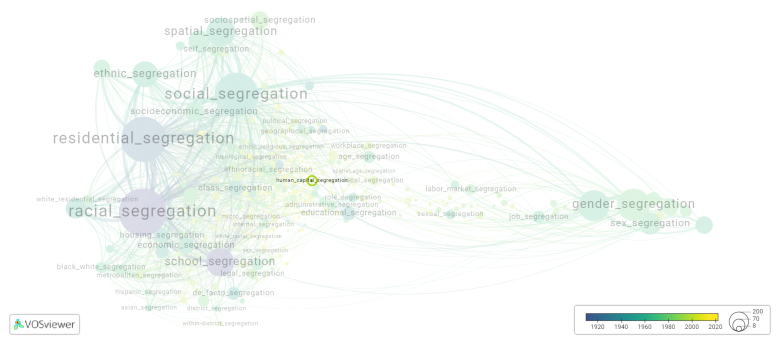Human capital segregation: Difference between revisions
(Creating page) |
(Creating page) |
||
| (10 intermediate revisions by the same user not shown) | |||
| Line 1: | Line 1: | ||
===== Date and country of first publication<ref>Date and country of first publication as informed by the Scopus database (December 2023).</ref>===== | |||
2008<br> | 2008<br> | ||
South Korea | South Korea | ||
===== Definition ===== | |||
refers to the unequal distribution of opportunities, resources, and benefits based on race, gender, age, and other social characteristics. This form of segregation can prevent individuals from accessing quality education, employment, and other opportunities, leading to a perpetuation of inequality and disadvantage. This can have negative effects on individuals, communities, and society as a whole. Employers and policymakers have a responsibility to address human capital segregation and promote diversity and inclusion in the workforce. | Human capital segregation refers to the unequal distribution of opportunities, resources, and benefits based on race, gender, age, and other social characteristics. This form of segregation can prevent individuals from accessing quality education, employment, and other opportunities, leading to a perpetuation of inequality and disadvantage. This can have negative effects on individuals, communities, and society as a whole. Employers and policymakers have a responsibility to address human capital segregation and promote diversity and inclusion in the workforce. | ||
==See also== | ==See also== | ||
==Related segregation forms== | |||
Human capital segregation is frequently discussed in the literature with the following segregation forms: | |||
[[social segregation]] | |||
[[File:human_capital_segregation.png|780x780px]] | |||
This visualization is based on the study [[Segregation_Wiki:About| The Multidisciplinary Landscape of Segregation Research]]. | |||
For the complete network of interrelated segregation forms, please refer to: | |||
* [https://tinyurl.com/2235lkhw First year of publication] | |||
* [https://tinyurl.com/2d8wg5n3 Louvain clusters] | |||
* [https://tinyurl.com/223udk5r Betweenness centrality] | |||
* [https://tinyurl.com/244d8unz Disciplines in which segregation forms first emerged (Scopus database).] | |||
==References== | ==References== | ||
==Notes== | ==Notes== | ||
<references /> | <references /> | ||
{{NoteAI}} | {{NoteAI}} | ||
== | ==Human capital segregation appears in the following literature== | ||
Lim U. (2008) | Lim U. (2008). The spatial dimension of human capital segregation: An empirical investigation for Seoul, Korea. ''Social Science Journal'', ''45''(4), 682-690. https://doi.org/10.1016/j.soscij.2008.09.016 | ||
Schlitte F. (2012) | Schlitte F. (2012). Local human capital, segregation by skill, and skill specific employment growth. ''Papers in Regional Science'', ''91''(1), 85-106. https://doi.org/10.1111/j.1435-5957.2011.00373.x | ||
Latest revision as of 07:17, 16 October 2024
Date and country of first publication[1][edit | edit source]
2008
South Korea
Definition[edit | edit source]
Human capital segregation refers to the unequal distribution of opportunities, resources, and benefits based on race, gender, age, and other social characteristics. This form of segregation can prevent individuals from accessing quality education, employment, and other opportunities, leading to a perpetuation of inequality and disadvantage. This can have negative effects on individuals, communities, and society as a whole. Employers and policymakers have a responsibility to address human capital segregation and promote diversity and inclusion in the workforce.
See also[edit | edit source]
Related segregation forms[edit | edit source]
Human capital segregation is frequently discussed in the literature with the following segregation forms:
This visualization is based on the study The Multidisciplinary Landscape of Segregation Research.
For the complete network of interrelated segregation forms, please refer to:
References[edit | edit source]
Notes[edit | edit source]
- ↑ Date and country of first publication as informed by the Scopus database (December 2023).
At its current state, this definition has been generated by a Large Language Model (LLM) so far without review by an independent researcher or a member of the curating team of segregation experts that keep the Segregation Wiki online. While we strive for accuracy, we cannot guarantee its reliability, completeness and timeliness. Please use this content with caution and verify information as needed. Also, feel free to improve on the definition as you see fit, including the use of references and other informational resources. We value your input in enhancing the quality and accuracy of the definitions of segregation forms collectively offered in the Segregation Wiki ©.
Human capital segregation appears in the following literature[edit | edit source]
Lim U. (2008). The spatial dimension of human capital segregation: An empirical investigation for Seoul, Korea. Social Science Journal, 45(4), 682-690. https://doi.org/10.1016/j.soscij.2008.09.016
Schlitte F. (2012). Local human capital, segregation by skill, and skill specific employment growth. Papers in Regional Science, 91(1), 85-106. https://doi.org/10.1111/j.1435-5957.2011.00373.x

